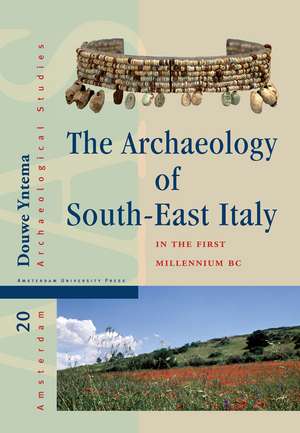The Archaeology of South–East Italy in the First – Greek and Native Societies of Apulia and Lucania between the 10th and the 1st Century BC: Amsterdam Archaeological Studies
Autor Douwe Yntemaen Limba Engleză Hardback – 26 dec 2013
Synthesizing some thirty years of archaeological research in southeastern Italy, this important study spans a millennium during which a variety of Mediterranean tribal communities evolved into a central part of the Roman Empire. Douwe Yntema draws on the archaeological record to explain how small groups developed into complex societies; how these societies adapted to increasingly wide horizons; and how Italian groups and migrants from the eastern Mediterranean created entirely new social, economic, cultural, and physical landscapes. In doing so, he offers a new perspective on the breathtaking changes that gave rise to the Roman Empire.
Preț: 569.45 lei
Preț vechi: 908.88 lei
-37% Nou
Puncte Express: 854
Preț estimativ în valută:
108.96€ • 113.77$ • 90.18£
108.96€ • 113.77$ • 90.18£
Carte indisponibilă temporar
Doresc să fiu notificat când acest titlu va fi disponibil:
Se trimite...
Preluare comenzi: 021 569.72.76
Specificații
ISBN-13: 9789089645791
ISBN-10: 9089645799
Pagini: 312
Ilustrații: 164 halftones
Dimensiuni: 211 x 301 x 23 mm
Greutate: 1.36 kg
Editura: Amsterdam University Press
Seria Amsterdam Archaeological Studies
ISBN-10: 9089645799
Pagini: 312
Ilustrații: 164 halftones
Dimensiuni: 211 x 301 x 23 mm
Greutate: 1.36 kg
Editura: Amsterdam University Press
Seria Amsterdam Archaeological Studies
Notă biografică
Douwe Yntema is professor of Mediterranean archaeology and a member of the Research Institute CLUE at the VU University Amsterdam. He also is a fellow of the Royal Netherlands Academy of Arts and Sciences.
Cuprins
1 Introduction: aim, concept and biases
2 Foreigners and fortifications: bronze age preludes
2.1 Introduction
2.2 From the Neolithic period till the Late Bronze Age
2.3 The Late Bronze Age (c. 1400-1200 BC)
2.4 The close of the Bronze Age (c. 1200-1000 BC)
3 The land and the people
3.1 The land: past and present
3.2 The people of the past
4 Huts, houses and migrants : the iron age (c. 1000 / 950 - 600 / 550 bc )
4.1 The beginnings of the Iron Age
4.2 Settlement and landscape
4.3 Raiders, traders and migrants
4.4 Long-distance contact, exchange and economy
4.5 Burials, social stratification and religion
4.6 Regionalization and craft
4.7 Summary
5 Temples, poleis and paramount chiefs: the ‘archaic - classical ’ period (c. 600 / 550 - 370 bc )
5.1 Introduction
5.2 The rise of urban centers and sanctuaries in the coastal strip of the Gulf of Taranto
5.3 Settlement and religion in areas with non-Greek populations
5.4 Burials and the rise of local and regional elites
5.5 Changes in craft
5.6 Economy, interrelations and long distance contacts
5.7 Ancient written sources and intellectual achievements
5.8 Summary
6 Towns, leagues and landholding elites: the early- Hellenistic period, c. 370 / 350 - 250 / 230 bc
6.1 Introduction: ancient written sources and history
6.2 Landscape and settlement
6.3 Mortals and immortals
6.4 Craft
6.5 Economy and external contact
6.6 Summary
7 Peasants , princes and senators: Southeast Italy
at the periphery of the roman world ( c. 250 / 230 - 100 / 80 bc )
7.1 Introduction: ancient written sources
7.2 Changing landscapes
7.3 Burials, religion and social landscape
7.4 Craft and economy
7.5 Summary: Romanization in southeast Italy
Bibliography
Index
2 Foreigners and fortifications: bronze age preludes
2.1 Introduction
2.2 From the Neolithic period till the Late Bronze Age
2.3 The Late Bronze Age (c. 1400-1200 BC)
2.4 The close of the Bronze Age (c. 1200-1000 BC)
3 The land and the people
3.1 The land: past and present
3.2 The people of the past
4 Huts, houses and migrants : the iron age (c. 1000 / 950 - 600 / 550 bc )
4.1 The beginnings of the Iron Age
4.2 Settlement and landscape
4.3 Raiders, traders and migrants
4.4 Long-distance contact, exchange and economy
4.5 Burials, social stratification and religion
4.6 Regionalization and craft
4.7 Summary
5 Temples, poleis and paramount chiefs: the ‘archaic - classical ’ period (c. 600 / 550 - 370 bc )
5.1 Introduction
5.2 The rise of urban centers and sanctuaries in the coastal strip of the Gulf of Taranto
5.3 Settlement and religion in areas with non-Greek populations
5.4 Burials and the rise of local and regional elites
5.5 Changes in craft
5.6 Economy, interrelations and long distance contacts
5.7 Ancient written sources and intellectual achievements
5.8 Summary
6 Towns, leagues and landholding elites: the early- Hellenistic period, c. 370 / 350 - 250 / 230 bc
6.1 Introduction: ancient written sources and history
6.2 Landscape and settlement
6.3 Mortals and immortals
6.4 Craft
6.5 Economy and external contact
6.6 Summary
7 Peasants , princes and senators: Southeast Italy
at the periphery of the roman world ( c. 250 / 230 - 100 / 80 bc )
7.1 Introduction: ancient written sources
7.2 Changing landscapes
7.3 Burials, religion and social landscape
7.4 Craft and economy
7.5 Summary: Romanization in southeast Italy
Bibliography
Index









